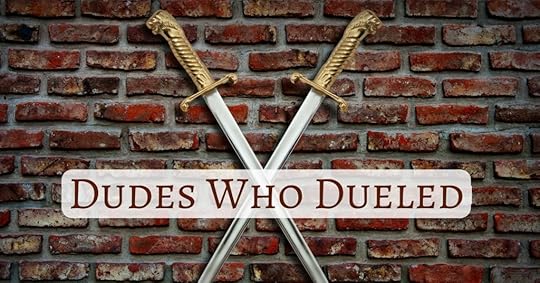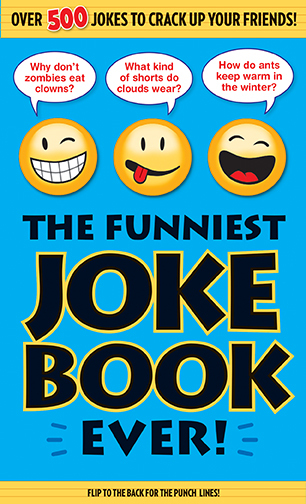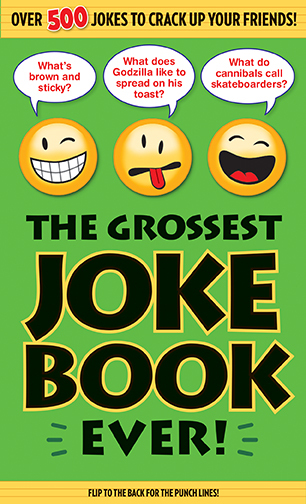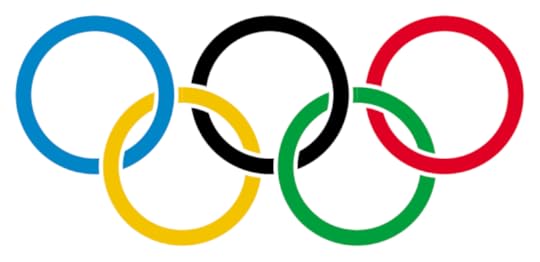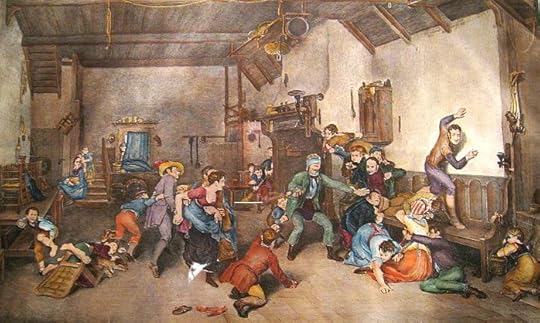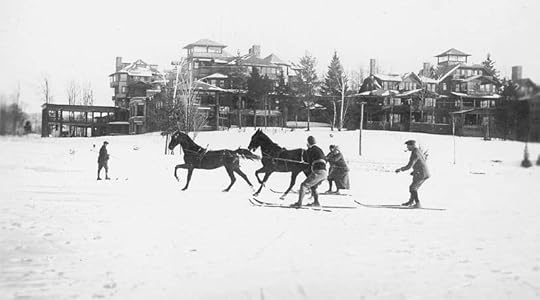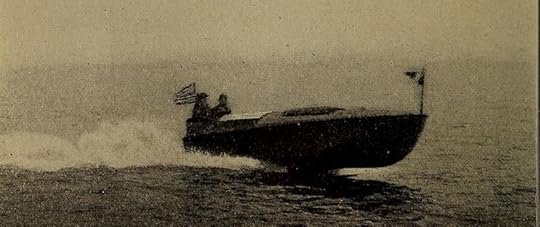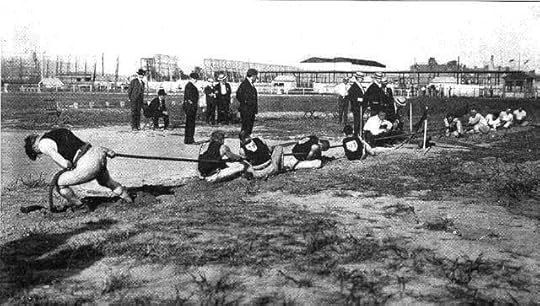Bathroom Readers' Institute's Blog, page 78
August 19, 2016
Bathroom Time Killers
Don’t have any plans this weekend? Fear not! We have lots of fun games for you to play…in the Throne Room!
Toilet Tenpin
What You Need: Ten golf tees, or other objects that can serve as bowling pins, and a few rubber bands to serve as bowling balls. Set the golf tees up in a triangle like bowling pins as far from the toilet as you can while still having them within reach—that way you can set them up over and over again and bowl as long as you want.
How to Play: Have you ever shot a rubber band like a gun? Make your hand into a pistol—curl your pinkie around the rubber band, then stretch the rubber band around the back of your thumb and over the tip of your index finger. Hold the pistol square in the center of your chest, lean back as far as you can, and when you’re ready to shoot, release your pinkie. Aim for the pins—try to knock them all down.
Trash Can Frisbee
What You Need: A wastepaper basket and some paper plates. If the wastepaper basket isn’t big enough to hold the paper plates, use a cardboard box or a paper shopping bag. Place the basket on the bathroom floor as far from the toilet as you can.
How to Play: Fling the paper plates like Frisbees—see if you can throw them into the wastepaper basket. For a bigger challenge, try to ricochet them off a wall into the basket.
Bathroom Darts
What You Need: A pie tin, a saucer, a small glass, and small objects you can throw. (Coins or caps from discarded toothpaste tubes work well.)
How to Play: Put the glass in the center of the saucer, and put the saucer in the center of the pie tin. Set them all down on the bathroom floor a few feet from the toilet. That’s your “dartboard.”
Toss the coins (“darts”) at your target—if they land in the glass, you get 10 points; if they land in the saucer, you get 5; if they land in the pie tin, you get 1. If you score too well, move the target farther away to make it more challenging.
Bathroom Blow Gun
What You Need: A soda straw, some wooden matches, and a hat.
How to Play: Turn the hat upside down and place it on the bathroom floor a good distance away from the toilet. Put a match in the straw, hold the straw up to your mouth, and blow. Try to shoot all the matches into the hat.
Fun With a Funnel
What You Need: A rubber ball and a funnel. The funnel needs to be big enough to hold the ball.
How to Play: Hold the pointy end of the funnel. Bounce the ball off the wall opposite the toilet and try to catch it in the funnel on the rebound.
Bathroom Bouncy Ball
What You Need: An egg carton and some Ping-Pong balls.
How to Play: Write different point values in each of the 12 cups of the egg carton, then place it on the bathroom floor a few feet from the toilet. Try to bounce the Ping-Pong balls into the egg carton. Start with one bounce, then, as your skills improve, move the carton farther away and bounce the balls twice before they go into the cups. Add up the values for your scores.
Bathroom Broken Neck Preventer
What You Need: All the stuff you just spread out all over the bathroom floor to play all these games we just taught you.
How to Play: Pick all that stuff up off the bathroom floor— before somebody gets killed!
The post Bathroom Time Killers appeared first on Trivia Books and Facts | Uncle John's Bathroom Reader.
August 16, 2016
4 Dudes Who Dueled (Some of Whom Died)
Their honor was besmirched, and they demanded satisfaction! Here are the stories of some famous folks who participated in duels (for better and for worse).
Ben Jonson
A contemporary of Shakespeare and the first playwright to preserve his works for the ages by publishing them, Jonson is most famous for the plays Volpone and Every Man in His Humour. He also killed another man of the theater in a duel. The reason for the battle between Jonson and actor Gabriel Spencer is unclear, but after the two took to swords, Jonson was standing and Spencer was dead. He admitted to the crime and was arrested. After he plead “benefit of the clergy”—essentially leniency by proving his literacy was at great value to society—Jonson was spared the death penalty and served just a year in prison.
George Handel
George Handel wrote the oratorio called Messiah (or “Handel’s Messiah”) and in 1704 he fought another composer, Johann Mattheson, to the death. The backstory: It was standard in opera at the time for the opera’s director to play the harpsichord—but Handel, the X Opera’s usual harpsichord player wouldn’t let Mattheson bump him. They came to blows and literally “took it outside,” fighting in the streets and pulling swords on each other. Mattheson tried to stab Handel in the chest but his weapon struck a metal button on Handel’s coat. The near-fatal blow spooked them both, and they called off the duel.
Aaron Burr vs. Alexander Hamilton
It figures prominently in the hot Broadway musical Hamilton, but just in case you haven’t seen it (or don’t remember your high school history classes), here’s the story of the duel between sitting Vice President Aaron Burr and former Secretary of the Treasury Alexander Hamilton. Formerly friends and associates who had helped secure the U.S.’s independence from Britain and establish a new government, by 1804 Burr and Hamilton were bitter rivals from opposite political factions who had frequently tried to outmaneuver each other and badmouthed one another. (Burr had once even taken a Senate seat away from Hamilton’s father-in-law, with whom he was closely politically aligned.) Hamilton actively campaigned against Burr in his 1804 campaign to be governor of New York, a major factor in Burr’s defeat. That was the final straw, and Burr challenged Hamilton to an “affair of honor.” Hamilton was an anti-dueling advocate, ever since his own son had lost a duel defending Hamilton’s honor in 1801. Hamilton had actually planned to fire his gun into the air and resolve his dispute with Burr another way. He didn’t get the chance—Burr shot him in the stomach.
The post 4 Dudes Who Dueled (Some of Whom Died) appeared first on Trivia Books and Facts | Uncle John's Bathroom Reader.
Lunch Box Jokes
Leave fun notes or jokes in you child’s lunch. Kids love goofy jokes they can impress their friends with. Also, it’s a simple gesture that lets them know you’re thinking about them. Download PDF here.
For more jokes check out our two newest joke books. We’ve stuffed the pages of these little joke books with the funniest jokes we could find. Old favorites, new favorites, and jokes soon to be banned from everywhere from Boston to the dinner table. Giggles, groans, and belly laughs pack every page.
The post Lunch Box Jokes appeared first on Trivia Books and Facts | Uncle John's Bathroom Reader.
August 15, 2016
3 of the Weirdest Cheating Scandals in Olympic History
While the history of the Summer Games is littered with stories of athletes who took performance-enhancing substances and got caught, these are about people who cheated at the Olympics in bizarre ways…and still got caught.
Double Trouble
Track and field star Madeline de Jesus represented Puerto Rico in the 1984 Summer Olympics. She was scheduled to compete in multiple events—the long jump and the 4-x400-meter relay. But de Jesus came down wrong during the long jump competition and injured herself. Unable to run in the relay, what was she to do? She brought in her twin sister, Margaret de Jesus, to run in her place. Margaret ran in a qualifying heat of the relay, helping the Puerto Rican team advance to the next stage. But then the Puerto Rico track and field coach heard about the ruse, and pulled the entire team out of contention. As for the de Jesus twins, both of them were banned from competing in any International Olympic Committee-sanctioned event.
Electric Boogaloo
In the 1970s, Russian athlete Boris Onischenko was one of the best fencers in the world. In the 1968 and 1972 Olympics, he competed for the Soviet Union, winning two silver medals and a gold in the Modern Pentathlon—a disparate collection of five sports, including shooting, swimming, running, horse jumping, and fencing. He entered the 1976 Olympics in Montreal as a favorite to take the fencing portion of the Modern Pentathlon, but he took some measures to ensure a victory. Fencers are rigged with electrical equipment to register a “touch” from an opponent, but during a match against Jim Fox of England, Onischenko scored a touch despite clearly not touching Fox. After Fox protested to judges, they examined Onischenko’s weapon and found that he’d rigged a high-tech electrical system in his sword that at the push of a button would electrically signal a touch. Onischenko was ejected from the Pentathlon (and physically removed from the Olympic Village), and Fox’s team went on to win the gold medal.
Masking the Issue
Onischenko was foolhardy to cheat in the fencing portion of the Modern Pentathlon, as a scandal in the event at the 1960 Olympics was still relatively recent. That year, nothing seemed to be going right for the Pentathlon squad from Tunisia—everyone fell off their horses during the equestrian part, a swimmer almost died during that section, and a Tunisian shooter nearly grazed one of the judges. And in the fencing event, the team straight up cheated. Rather than sending out multiple fencers for each of the individual bouts, they just sent out the same athlete every time. The reasoning: Since he was wearing one of those thick, face-obscuring fencing masks, nobody would notice. Judges noticed after the same fencer went up for three straight bouts.
The post 3 of the Weirdest Cheating Scandals in Olympic History appeared first on Trivia Books and Facts | Uncle John's Bathroom Reader.
3 Gadgets Invented by Famous Writers
Writers will do anything to get out of writing (trust us, this is hard work). Some avoid a blank page or fend off writer’s block by going to the trouble of inventing something.
Lewis Carroll’s Nyctograph
Today, writers struck by late-night inspiration in bed can simply reach for their smartphone, and open up a note-taking app. But before the nifty invention that is modern electricity, writers had a heck of a time jotting down those revelations. By the time one had gotten out of bed, found matches for a candle, and dipped a quill in ink, the idea was…gone. In 1891, Alice’s Adventures in Wonderland author Lewis Carroll (real name: Charles Dodgson) conceived a system that would enable him to write a quick note in bed without the aid of light. It doesn’t sound like it’s simpler than finding a candle and a quill, though: Carroll’s Nyctograph consisted of two rows of eight boxes cut out of thick cardstock. Then he developed and memorized a complicated code compiled of dashes and dots to mimic the alphabet, using the boxes as a guide.
Roald Dahl’s Heart Valve
If necessity is the mother of invention, there’s nothing more necessary to a parent than healing a sick child. After James and the Giant Peach author Roald Dahl’s son, Theo, was in a car accident that left him with water on the brain, Dahl, with the help of an engineer named Stanley Wade and Theo’s neurosurgeon, Kenneth Till, developed a valve that allowed the excess fluid to safely drain out of brain. The cerebral shunt was named the Wade-Dahl-Till valve and was used in thousands of operations in the 1960s before newer devices rendered it obsolete.
Margaret Atwood’s Longpen
Writers are often reclusive, so it’s no surprise that the Longpen was conceived by an author in in the middle of a long and dreary book tour. Developed in 2004 by Canadian novelist Margaret Atwood (The Handmaid’s Tale), it allows a writer to remotely sign books via a robotic arm and video conferencing. Atwood claims that the device provides fans the “one-on-one” experience that they want out of a book signing, while the author, is in turn, able to stay nice and cozy in their home, presumably surrounded by cats and half empty cups of tea.
The post 3 Gadgets Invented by Famous Writers appeared first on Trivia Books and Facts | Uncle John's Bathroom Reader.
August 12, 2016
Child’s Play
What did children do before there were TVs and computers? These old children’s games are taken from the 1920s book Games for the Playground, Home, School and Gymnasium, by Jessie H. Bancroft.
HUCKLE, BUCKLE, BEAN STALK
Number of Players: 5 to 30
How It’s Played: A thimble, cork, ring, or other small object is used for hiding. All of the players leave the room save one, who places the object in plain sight but where it is unlikely to be seen, as on the top of a picture frame, in a corner on the floor, etc. It may be placed behind any other object, as long as it can be seen without moving any object. Once the object has been placed, the players are called back to the room, and all begin to look for it. When one spies it, he does not disclose this fact, but quietly takes a seat, and says, “Huckle, buckle, bean stalk!” which indicates that he knows where the object is. The game keeps on until all of the players have located the object, or until the leader calls the hunt closed. The first one to find the object hides it for the next game. Please view this video.
THE MINISTER’S CAT
Number of Players: 5 or more
How It’s Played: The first player says, “The minister’s cat is an avaricious cat,” using an adjective that begins with “a” to describe the cat. The next player makes a remark about the cat, using the same initial letter for the adjective; for instance, that it is an “aggressive” cat. This is continued, each player using a different adjective beginning with the letter “a,” until the game has gone entirely around the circle. The first player then makes a similar remark about the cat, using an adjective beginning with “b.” This goes around, and so on through the alphabet. Any player who fails must drop out. The player who lasts longest wins.
DUMB CRAMBO
Number of Players: 10 to 30
How It’s Played: The players are divided into two parties. One party goes outside the room; those remaining choose a verb, which is to be guessed by the other party. The outside party is told a word that rhymes with the chosen verb. They consult among themselves, decide on a verb that they think may be the right one, enter the room, and without speaking, act out the verb they have guessed. The inside party must decide from this pantomime if the correct verb has been guessed. If correct, they clap their hands. If not, they shake their heads. No speaking is allowed on either side. If the outside party is wrong in their guess, they retire and try again, repeating this play until they hit on the right word, when the two sides change places.
ANIMAL BLINDMAN’S BLUFF
Number of Players: 10 to 20
How It’s Played: One player is blindfolded and stands in the center of a circle with a stick or cane in his hand. The other players dance around him in a circle until he taps three times on the floor with his cane, when they must stand still. The “blindman” then points his cane at a player, who must take the opposite end of the cane in his hand. The blind man then commands him to make a noise like some animal, such as a cat, dog, cow, sheep, lion, donkey, duck, or parrot. From this the blind man tries to guess the name of the player. If the guess is correct, they change places. If wrong, the game is repeated with the same blind man. The players should try to disguise their voices as much as possible when imitating the animals, and much sport may be had through the imitation. Players may also disguise their height, to deceive the blind man, by bending their knees to seem shorter or rising on toes to seems taller.
BLIND BANANA FEED
Number of Players: 6 to 20
How It’s Played: Blindfold several couples. Give a peeled banana to each person. Have the couples clasp left hands, and at the signal to start they begin trying to feed one another. It may get messy, so it is well to provide bibs for the players by cutting a hole in a sheet of newspaper and dropping it over the head. Whichever team finishes their bananas first is the winner
The post Child’s Play appeared first on Trivia Books and Facts | Uncle John's Bathroom Reader.
August 2, 2016
Olympic Myths
Every two years, we’re treated to another round of Olympics. Whether you watch them or not, it’s impossible to avoid all the hype—which, it turns out, isn’t all true. Next time someone refers to “Olympic tradition,” read them this.
THE MYTH: Athletes who competed in the ancient Greek Olympics were amateurs.
THE TRUTH: Technically, maybe. But in fact, they were handsomely rewarded for their victories. “Contrary to popular belief,” says David Wallechinsky in his Complete Book of the Olympics, “the Ancient Greek athletes were not amateurs. Not only were they fully supported throughout their training, but even though the winner received only an olive wreath at the Games, at home he was amply rewarded and could become quite rich.” Eventually, top athletes demanded cash and appearance fees—just like today.
THE MYTH: In ancient Greece, the Olympics were so important that everything stopped for them—even wars.
THE TRUTH: No war ever stopped because of the Olympics. But wars didn’t interfere with the games because: 1) participants were given nighttime safe-conduct passes that allowed them to cross battlefields after a day’s fighting was done, and 2) the Olympics were part of a religious ceremony, so the four Olympic sites—including Delphi and Olympia—were off-limits to fighting.
THE MYTH: To honor ancient tradition and discourage commercialism, organizers of the modern Olympics decided that only amateur athletes could compete.
THE TRUTH: Not even close. It was “amateurs only” strictly to keep out the riff-raff. Baron Coubertin, the man responsible for bringing back the Olympics in 1896, was a French aristocrat who wanted to limit competitors to others of his social class. “He saw the Olympics as a way to reinforce class distinctions rather than overcome them,” writes one historian. Since only the rich could afford to spend their time training for the games without outside support, the best way to keep lower classes out was to restrict them to amateurs.
THE MYTH: The torch-lighting ceremony that opens the games originated with the ancient Greeks.
THE TRUTH: It has no ancient precedent—it was invented by the Nazis. The 1936 Olympics took place in Berlin, Germany, under Hitler’s watchful eye. Carl Diem, who organized the event for the Führer, created the first lighting of the Olympic flame to give the proceedings “an ancient aura.” Since then, the ceremony has become part of Olympic tradition…and people just assume it’s much older than it really is.
THE MYTH: The 5-ring Olympic symbol is from ancient Greece.
THE TRUTH: The Nazis are responsible for that myth, too. According to David Young’s book, The Modern Olympics, it was spread in a Nazi propaganda film about the Berlin Games.
THE MYTH: Adolf Hitler snubbed U.S. runner Jesse Owens at the 1936 Olympics in Berlin.
THE TRUTH: This is one of the enduring American Olympic myths. Hitler, the story goes, was frustrated in his attempt to prove Aryan superiority when Owens—an African American—took the gold. The furious Führer supposedly refused to acknowledge Owens’s victories. But according to Owens himself, it never happened. Hitler didn’t congratulate anyone that day because the International Olympic Committee had warned him he had to congratulate “all winners or no winners.” He chose to stay mum.
THE MYTH: Drugs have always been taboo in the Olympics.
THE TRUTH: Drugs weren’t outlawed until the 1968 Games. In fact, according to the Complete Book of the Olympics, drugs were already in use by the third modern Olympic Games: “The winner of the 1904 marathon, Thomas Hicks, was administered multiple doses of strychnine and brandy during the race.”
The post Olympic Myths appeared first on Trivia Books and Facts | Uncle John's Bathroom Reader.
5 Weird August Holidays You Should Celebrate
Myth: August is the only month without any major holidays in it. Truth: August has plenty of holidays in it…although none we’d call “major.” Here are a bunch of silly observances to look forward to in the comic weeks.
August 2: National Ice Cream Sandwich Day
Summer has been going on so long that for some people regular old ice cream has gotten boring. Today is the day to mix it up a little with ice cream pressed between two cookies, invented by Forbes Field (it’s in Pittsburgh) ice cream vendor Jerry Newberg in 1945.
August 6: National Mustard Day
If it’s the first Saturday in August, it must be the day to commemorate that yellow (or brown) and spicy (or really) spicy condiment. Sponsored by the National Mustard Museum of Middleton, Wisconsin, since 1991, the official celebration brings in more than 6,000 people each year to try out tons of different kinds of mustard.
August 8: Sneak Some Zucchini Onto Your Neighbor’s Porch Day
That title is far more honest than “National Zucchini Day.” This time of year is zucchini harvesting time most of the country, and if you’ve ever grown your own zukes, you know that you end up with way more than you can ever use. (There’s always a huge box of them in the break room at the B.R.I.—nobody will own up to bringing them in.) Unless you want to be drowning in summer salads and zucchini bread, you’ve simply got to pass it off to the family next door.
August 10: Lazy Day
We were going to look up who thought of this holiday, but we’re so tired, and there’s a lot of new stuff on Netflix to check out…
August 17: National Thriftshop Day
Likely started by a thrift store that wanted to boost business, it’s a great day to either clear out your closet before the fall, or pick up some “new” (or at least new to you) fall fashions. And they’re usually so cheap (hence the name “thrift” store), and benefit charity.
The post 5 Weird August Holidays You Should Celebrate appeared first on Trivia Books and Facts | Uncle John's Bathroom Reader.
August 1, 2016
5 Former Olympic Sports
There are dozens of Olympic events, but there’s only so much time and space. Here are some sports that were once, but are no longer, part of the Olympic games.
Skijoring
What is skijoring, exactly? It’s a combination of equestrian, dog sledding, and skiing. Human athletes strap on skis, and let horses pull them through the snow, and whoever crosses the finish line the fastest wins. This was a demonstration event at the 1928 Winter Olympics in Switzerland, but it wasn’t popular enough for the International Olympic Committee to make it an official event and hold it again.
Motor boating
In 1908, speedboat racing was introduced into Olympic competition. But they were held in London, where even in summer the weather gets a little dicey. A storm hit during the first big day of competition. Out of nine scheduled races, six were cancelled. In the three races that actually happened, only one boat managed to finish in each. The fastest boat topped out at 19 mph. Ultimately, the IOC decided that all sports involving motors weren’t as athletic as other sports and did away with the event.
Tug of war
Believe it or not, the playground game was a regular part of the Olympics in the first two decades of the 20th century. Teams of five to eight entered, and countries would routinely enter more than one team, which explains how the U.S. won the gold, silver, and bronze medals at the 1904 Olympics.
Pigeon shooting
Only once—at the 1900 Olympics in Paris—did the Summer Games involve killing live animals. Pigeons were released, and the shooter had to gun down as many as possible; two misses, and they were out. Gold medalist Leon de Lunden of Belgium shot 21 birds.
Dueling pistol shooting
An actual duel would’ve caused quite a sensation, but not even in the early days of the Olympics (where shooting birds was fine) were athletes allowed to shoot at each other. At the first modern Olympics in 1896, competitors shot at dummies with targets painted onto their chests.
The post 5 Former Olympic Sports appeared first on Trivia Books and Facts | Uncle John's Bathroom Reader.
I Want My MTV Trivia!
On August 1, 1981—35 years ago today—MTV went on the air in a handful of cable system across the country. You probably know that the first video played was the Buggles’ “Video Killed the Radio Star,” but did you know these behind-the-scenes stories from some iconic early music videos?
“Money for Nothing”
British band Dire Straits was in a career slump in the mid-‘80s, and in desperation the band’s manager asked an MTV executive how the band could get some exposure. The exec’s sarcastic response: write a hit song and make a hip video. Dire Straits frontman Mark Knopfler proceeded to write a song full of references to MTV. “Money for Nothing” was sung from the point of view of a blue collar worker complaining about how easy a job rock stars have, including a line about how “they play their records on the MTV.” The song’s hook: Sting singing “I want my MTV,” the network’s tagline. It worked: the band produced an innovative CGI video for the song and in 1986 won the third-ever MTV Video Music Award for Video of the Year. (And Brothers in Arms, the album with “Money for Nothing” on it, sold nine million copies.)
“Beat It”
Michael Jackson’s 1983 video was among the first music videos to feature a plot, rather than just consist of a musician lip syncing or pretending to play their instrument to the pre-recorded track. The video emphasizes the song’s pleases for inner-city gangs to get along. To add a touch of authenticity to the shoot, the 80 actors in the video’s climactic gang fight showdown were real-life members of rival Los Angeles street gangs the Crips and Bloods, and the video was shot in L.A.’s Skid Row neighborhood. The leaders of the two gangs—who have a dance-off rather than a fight—were professionals, however: Vincent Patterson and Michael Peters (who was the video’s choreographer). They played bitter rivals, but in real life Patterson and Peters were dating.
“Mickey”
Toni Basil, who had gotten her start as a dancer and choreographer on Shindig! In 1964, recorded the song “Mickey” in 1981. The song had a cheerleader kind of sound to it, so she choreographed a cheerleading routine. Basil even wore her old high school cheerleading uniform. (Fun fact: the part where two cheerleaders jump through the middle of the formation is illegal in cheerleading competitions now because it’s too dangerous.)
The post I Want My MTV Trivia! appeared first on Trivia Books and Facts | Uncle John's Bathroom Reader.



